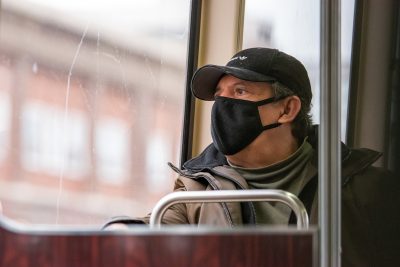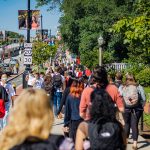The Massachusetts Bay Transportation Authority has begun distributing free masks during popular commuting times as part of their campaign to prevent coronavirus transmission.

The Ride Safer campaign provides face coverings at peak travel times and has added signage and messaging to encourage riders to follow COVID-19 regulations, according to Danny Levy, the MBTA’s chief customer officer. Its web page provides a “behind-the-scenes” look at the cleaning and disinfecting of stations and vehicles.
“Ride Safer promotes a safer travel environment through communications in stations, on platforms, and in vehicles,” Levy wrote in an email. “It is an initiative to promote a new behavior and a safer travel environment.”
Riders can obtain face masks from Transit Ambassadors and MBTA Customer Service Agents between 6:30 a.m. and 9 a.m. and 4 p.m. to 6 p.m. Monday through Friday.
Seven key stations — Charles/MGH, Downtown Crossing, Forest Hills, Hynes Convention Center, Maverick, Orient Heights, Park Street and Quincy Center — were designated as distribution sites because of their steady ridership throughout the pandemic, Levy wrote.
Signage directs those in need of a mask to MBTA employees who will hand out face coverings.
The masks are supplied through a partnership between the MBTA and New Balance. The fitness brand provided 100,000 masks for distribution to riders, according to an MBTA press release.
“New Balance is proud to help meet the continued needs for masks in Boston and its surrounding communities,” Dave Wheeler, New Balance’s chief operating officer, said in another press release.
The MBTA is looking for other industry partners to “follow New Balance’s lead” and help commuters stay safe, Levy wrote.
Jarred Johnson, director of TransitMatters, which advocates for equitable transportation, wrote in an email the initiative is “critical.”
“All the data supports the idea that transit is safe so long as riders wear masks,” Johnson wrote. “Making masks readily available to riders will make the T safer and hopefully will reduce unnecessary rider-police interactions due to mask enforcement.”
In addition to the Ride Safer campaign, the MBTA is providing crowding information for buses and the T — which is available on the MBTA website. The website also urges riders to take advantage of the Transit app, which allows users to plan their trips, along with digital signs displaying arrival times at bus stops.
These platforms update in real time to show current crowding levels for most bus routes and crowding trends for three subway lines, represented by diagrams of people — one person represents not crowded, two represent some crowding and three means crowded, according to the MBTA website.
The MBTA hopes to continue improving rider safety by adding more masks, personnel and stations to the program, Levy wrote.
“When we wear a mask, we don’t just do it for ourselves — we do it for those around us,” Levy wrote. “Even just one mask can make a world of difference in helping to slow the spread of COVID-19.”



